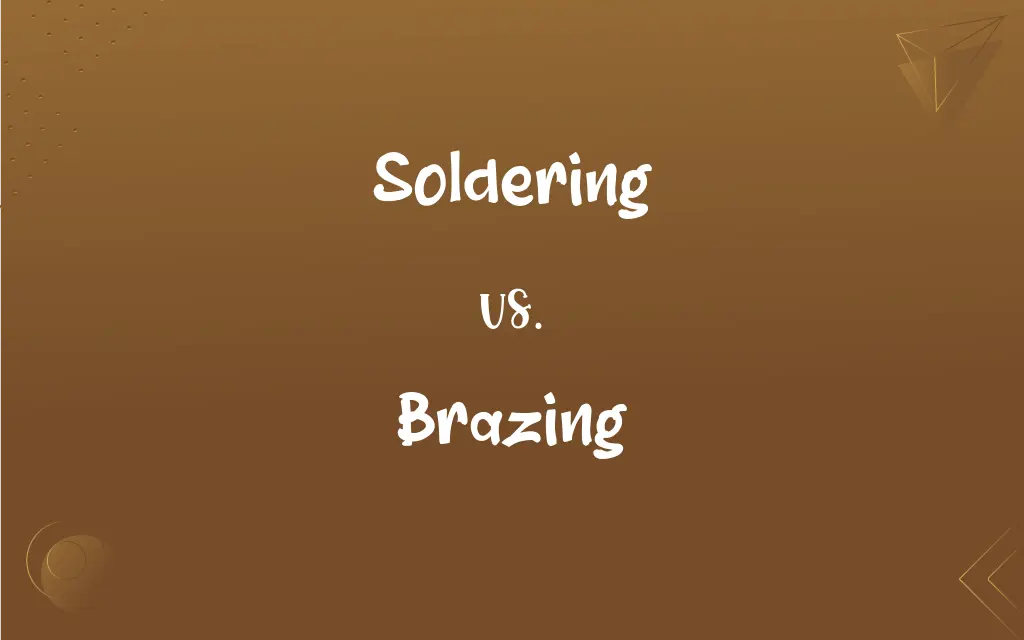Soldering vs. Brazing: What's the Difference?
Edited by Aimie Carlson || By Harlon Moss || Updated on October 24, 2023
Soldering involves joining metals using a filler with a melting point below 840°F, while brazing uses a filler that melts above this temperature.

Key Differences
Soldering is a process where two pieces of metal are joined using a molten filler metal that has a melting point below 840°F. On the other hand, brazing joins metals using a filler metal that melts above 840°F.
Both soldering and brazing are popular for creating strong joints between metals, but they differ in their applications and strength. While soldering is often seen in electrical circuits and plumbing because of the lower temperatures involved, brazing is used in applications requiring stronger joints, like in bicycle frames or HVAC systems.
Soldering doesn't typically alter the properties of the metals being joined since it uses lower temperatures. In contrast, brazing, with its higher temperatures, can affect the metal's mechanical and structural properties, leading to stronger bonds.
The equipment and techniques for soldering typically involve a soldering iron or gun and solder, which is a combination of tin and lead, or sometimes other materials for specific applications. Brazing, however, utilizes torches that can reach much higher temperatures and brazing rods made of materials like silver or bronze.
In essence, while both soldering and brazing serve to join metals, the key distinction lies in their temperature thresholds, application areas, and the strength of the joints they produce.
ADVERTISEMENT
Comparison Chart
Melting Point of Filler
Below 840°F (450°C).
Above 840°F (450°C).
Application Areas
Common in electrical circuits, electronics, and plumbing.
Used in HVAC systems, bicycle frames, and other applications requiring stronger joints.
Temperature's Effect on Metals
Does not significantly alter the properties of the metals being joined.
Can change the mechanical and structural properties of the metals.
Equipment Used
Soldering iron or gun, solder (tin-lead alloy).
Torch, brazing rods (silver, bronze).
Strength of Joint
Produces less strong joints compared to brazing.
Produces very strong joints.
ADVERTISEMENT
Soldering and Brazing Definitions
Soldering
Solder, a common filler, usually contains tin and lead.
The craftsman preferred lead-free solder for environmental reasons.
Brazing
The process requires torches that can reach high temperatures.
He adjusted the torch for the brazing procedure.
Soldering
It is often used in electrical and electronics applications.
She's adept at soldering tiny components on circuit boards.
Brazing
It results in very strong joints ideal for structural applications.
Brazing is preferred for applications where strength is paramount.
Soldering
Soldering is the process of joining metals using a low-melting-point filler.
He's soldering the wires to fix the circuit.
Brazing
Brazing often uses silver or bronze as filler materials.
The artisan used silver for brazing the jewelry pieces.
Soldering
Soldering requires a soldering iron or gun.
The technician grabbed his soldering iron to mend the connection.
Brazing
Brazing joins metals using a filler that melts at high temperatures.
The mechanic was brazing the broken parts of the bicycle frame.
Soldering
The soldering joint forms when the solder cools and solidifies.
Proper soldering ensures a reliable and long-lasting connection.
Brazing
Brazing can modify the properties of the metals being joined.
The properties of the base metals remained intact despite the brazing.
Soldering
Any of various fusible alloys, usually tin and lead, used to join metallic parts.
Brazing
To make of or decorate with brass.
Brazing
To make hard like brass.
Brazing
To solder (two pieces of metal) together using a hard solder with a high melting point.
Brazing
Present participle of braze
Brazing
A method of joining metals by using heat and a filler
FAQs
What's a common material used for solder?
A common solder is an alloy of tin and lead, though there are lead-free variants available.
Is brazing stronger than soldering?
Yes, brazing typically produces stronger joints than soldering.
Can brazing alter the properties of metals?
Yes, the higher temperatures in brazing can modify the mechanical and structural properties of the metals being joined.
What's the primary filler material for brazing?
Common brazing fillers include silver and bronze.
Can brazing be done on stainless steel?
Yes, brazing can be effectively performed on stainless steel using the appropriate filler material.
What are common applications of soldering?
Soldering is commonly used in electronics, electrical circuits, and plumbing.
Are there any safety concerns with soldering?
Yes, soldering involves molten material and can produce fumes, so it's essential to work in a well-ventilated area and use protective equipment.
Can soldering be used for jewelry?
Yes, soldering is often used in jewelry-making to join metal pieces.
Can brazing be used for repairing automotive parts?
Yes, brazing is often used for repairing or joining automotive components due to its strength.
Are there alternatives to soldering and brazing for joining metals?
Yes, alternatives include welding, mechanical fastening, and adhesive bonding.
Is soldering suitable for heavy-duty industrial applications?
While soldering is versatile, brazing is often chosen for heavy-duty applications due to its stronger joints.
How long does a brazed joint take to cool and set?
The cooling time varies based on the metals and the size of the joint but typically takes a few minutes to several hours.
Do soldered joints conduct electricity?
Yes, soldered joints are conductive, making them suitable for electrical applications.
Which method is faster: soldering or brazing?
The speed varies based on the specific application, but generally, soldering can be quicker due to its lower temperatures.
What's the primary distinction between soldering and brazing?
The main difference is the melting point of the filler used; soldering uses a filler that melts below 840°F, while brazing uses one that melts above this temperature.
What's the advantage of using lead-free solder?
Lead-free solder is environmentally friendly and reduces the risk of lead exposure, which is toxic.
Is special training required for soldering or brazing?
While basic soldering can be self-taught, professional applications for both soldering and brazing often require training.
Which method is better for joining bicycle frames: soldering or brazing?
Brazing is preferred for bicycle frames because of its stronger joints.
What equipment is required for soldering?
Typically, a soldering iron or gun and solder are needed.
Why might someone choose brazing over welding?
Brazing allows for joining dissimilar metals and doesn't melt the base metals, which can be advantageous in certain applications.
About Author
Written by
Harlon MossHarlon is a seasoned quality moderator and accomplished content writer for Difference Wiki. An alumnus of the prestigious University of California, he earned his degree in Computer Science. Leveraging his academic background, Harlon brings a meticulous and informed perspective to his work, ensuring content accuracy and excellence.
Edited by
Aimie CarlsonAimie Carlson, holding a master's degree in English literature, is a fervent English language enthusiast. She lends her writing talents to Difference Wiki, a prominent website that specializes in comparisons, offering readers insightful analyses that both captivate and inform.
































































